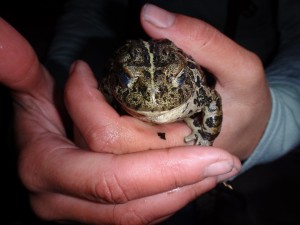It’s uncommon to see people out and about in the reeds surrounding Strawberry Reservoir, especially in the middle of the night. But last week, anyone passing by after dark would have seen a dozen headlamps illuminating the small streams that run through the reeds and into the reservoir. Their owners were looking for toads.
Volunteers and members from the Division of Wildlife Resources, Hogle Zoo and the U.S. Forest Service spent three nights catching boreal toads to survey the population. Utah has seen a decline in toad populations and Wildlife Resources and is trying to learn why and what they can do to preserve populations.

“The decline was one of those things that was happening with no one noticing or even looking,” said Chris Crockett, aquatic biologist for the Division of Wildlife Resources. “When we became interested and started visiting some of these sites that historically had toads, we couldn’t find them.”
Utah doesn’t have many native amphibian species, and a small number of those are toads. The boreal toad is a high-elevation species that can be found in Utah’s mountain ranges. In central Utah there are only two known populations: one in Little Cottonwood Canyon and one at Bryant’s Fork in Strawberry Reservoir.
Volunteers and activists want to raise more awareness about the toads and other wildlife in the state. “A lot of people really aren’t familiar with the amphibians in the state; they don’t know that they’re in decline,” said Liz Larsen, director of conservation and sustainability at Hogle Zoo.
The zoo and Wildlife Resources have created a free app called “Amphibians of Utah” to help identify amphibians people may encounter while outdoors. “With people all over the place you never know when they may encounter something,” Larsen said. “We’re hoping that people may identify or report a toad in a location that we’re not aware of.” The app includes the sounds the amphibians make, pictures and locations where they may be found. If someone does encounter an amphibian, they can log their information, and it can be tracked.

Participating organizations want to work with citizens to help preserve and learn about unique amphibians in Utah. “We’ve been trying to get citizens involved in helping us find the toad populations,” Crockett said. “That’s actually how we rediscovered the toad population up Little Cottonwood Canyon.”
Although most people wouldn’t consider toads to be a charismatic species, the boreal toads have some unique characteristics. “They have a nice little racing stripe down their middle, and they smell like peanut butter,” Larsen said. Researchers hope citizens will recognize how special Utah’s boreal toads are and will take action to do what they can to help preserve them.
Anyone looking to help should expect a hands-on and unique experience. “I have yet to go out anywhere and do anything like this and have it not be fun,” said volunteer Clark Gallow.
If you want to get involved, visit the Division of Wildlife Resources website.




